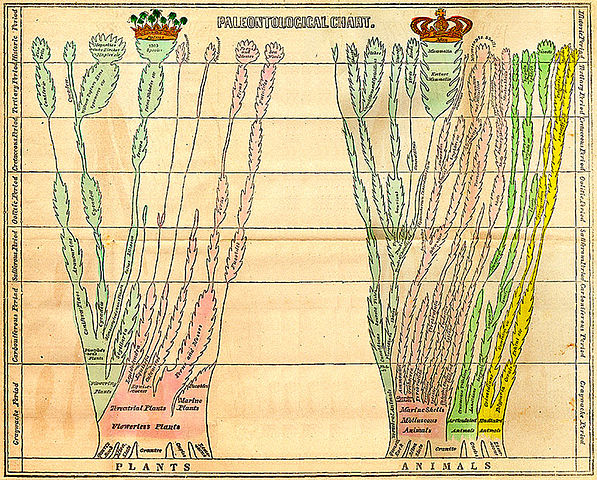
| Palaeos |  |
The Phylogenetic Tree |
| Systematics | Early) trees |
| Page Back | Unit Home | Page Next |
| Unit Back: Linnaean taxonomy | Unit Up | Unit Next: Evolutionary systematics |
What came before the evolutionary tree was the Great Chain of Being, the idea thatr everything in existence can be arranged in a single linear series. The premise appeared in the Middle Ages through a synthesis of Greek philosophy (chiefly Aristotle), Christian theology and angelology, and justification for social stratification. It continued to form a central understanding of how the world works right up until the 18th century, when it eventually collapsed under its own weight in attempting to organise and incorporate the ever growing amount of knowledge about the natural world.
By the late 18th century it had became clear that nature could not be portrayed in a single dimension. The great German naturalist, Peter Simon Pallas, in his Elenchus Zoophytorum (1766) showed that no linear scale can represent the mutual relations of organised beings; whereas the branching tree is the appropriate metaphor.
Although the mutability of species may have appeared in paintings (Barbagli 2009) and trees have been used as a metaphor for other purposes (Porphyrian tree) earlier than 1800, the combination of the concept of branching evolution and the tree image did not appear before 1800. The earliest tree of life was published by the French botanist Augustin Augier in 1801. It shows the relationships between members of the plant kingdom. (Wikipedia)
the French zoologist and evolutionist Jean-Baptiste Lamarck, produced the first branching tree of animals in his Philosophie Zoologique (1809). In contrast to the standard format popularised by Haeckel and others, it was an upside-down tree starting with worms and ending with mammals. However, Lamarck did not believe in common descent of all life. Instead, he advocated a temporalised or ascending path along the great chain of being, believing that life consists of separate parallel lines advancing from simple to complex [Bowler 2003]
 Paleontological Chart in the publication Elementary Geology (1840) by Edward Hitchcock. It shows two trees: one for plants, one for animals. Image scanned by J. David Archibald. Public domain, Wikipedia. |
The American geologist and the American geologist Edward Hitchcock, published the first Tree of Life based on paleontology in his Elementary Geology (1840). (Archibald 2009). On the vertical axis are paleontological periods. Hitchcock made a separate tree for plants (left) and animals (right). The plant and the animal tree are not connected at the bottom of the chart. Furthermore, each tree starts with multiple origins. Although Hitchcock's trees were branching, they were not real evolutionary trees, because Hitchcock believed that a deity was the agent of change. Darwin's abstract tree was the first evolutionary tree of life (Wikipedia)
| Page Back | Unit Home | Page Top | Page Next |
page MAK130328 Material by MAK Creative Commons License; other material as stated.